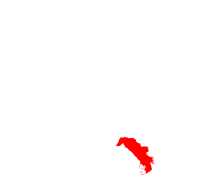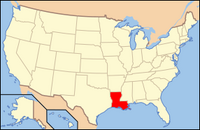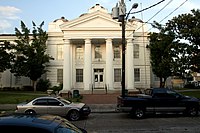| ||||||||||||||
| Lafourche Parish, Louisiana | |
Lafourche Parish Courthouse
| |
 Location in the state of Louisiana | |
 Louisiana's location in the U.S. | |
| Founded | 1807 |
|---|---|
| Named for | la fourche, French for the fork |
| Seat | Thibodaux |
| Largest city | Thibodaux |
| Area - Total - Land - Water |
1,474 sq mi (3,818 km²) 1,068 sq mi (2,766 km²) 406 sq mi (1,052 km²), 28 |
| Population - (2020) - Density |
97,557 |
| Congressional districts | 1st, 6th |
| Time zone | Central: UTC-6/-5 |
| Website | www.lafourchegov.org |
Lafourche Parish (French: Paroisse de la Fourche) is a parish located in the south of the U.S. state of Louisiana. The parish seat is Thibodaux.[1] The parish was formed in 1807.[2] It was originally the northern part of Lafourche Interior Parish, which consisted of the present parishes of Lafourche and Terrebonne. Lafourche Parish was named after the Bayou Lafourche.[3] City buildings have been featured in television and movies, such as in Fletch Lives, due to its architecture and rich history. At the 2020 census, its population was 97,557.[4]
Long a center of sugar cane plantations and sugar production, in November 1887 the parish was the site of the Thibodaux Massacre. After state militia were used to suppress a massive Knights of Labor strike involving 10,000 workers in four parishes, many African Americans retreated to Thibodaux. Local paramilitary forces attacked the men and their families, killing an estimated 50 persons, and hundreds more were missing, wounded, and presumed dead in one of the deadliest incidents of labor suppression and racial terrorism.
Lafourche Parish is part of the Houma-Thibodaux metropolitan statistical area. People of the state-recognized Native American Houma Tribe live in both Lafourche and Terrebonne parishes.
History[]
South Louisiana became known as Sugarland, and Lafourche one of the sugar parishes, where sugar cane plantations were established before and after the Civil War. They required the labor of large numbers of enslaved African Americans. In the postbellum era, they comprised from 50 to 80 percent of the population in most of the sugar parishes.[5]
Particularly after Reconstruction, whites in the parish used violence and intimidation against the large population of freedmen to suppress Republican voting and re-establish white supremacy, but were less successful than in North Louisiana until after disenfranchisement of blacks at the turn of the century.[5] From 1877 through the early 20th century, there were 52 lynchings of African Americans in Lafourche Parish. Most of the deaths were due to white suppression of labor unrest in 1887; blacks were skilled sugar workers and had begun to organize for better wages and conditions.[5] Some 10,000 workers had struck in Lafourche and three other parishes during the critical harvest period. At the request of the planters, the state sent in militia against the workers to break the strike.
In what was called the Thibodaux Massacre of November 22, 1887, local whites organized by leaders of the town killed up to 50 blacks who had taken refuge in the African-American quarters after a major Knights of Labor strike was called on sugar plantations. Hundreds more were wounded or missing.[6]
The total deaths in this parish due to this racial terrorism were the highest of any parish in the state and nearly twice as high as some others among the six parishes with the highest totals. In general, most of the lynching and racial terrorism took place in the late 19th and early 20th centuries.
Geography[]
According to the U.S. Census Bureau, the parish has a total area of 1,474 square miles (3,820 km2), of which 1,068 square miles (2,770 km2) is land and 406 square miles (1,050 km2) (28%) is water.[7] To the south of the parish is the Gulf of Mexico.
Major highways[]
 Interstate 49 (future)
Interstate 49 (future) U.S. Highway 90
U.S. Highway 90Louisiana Highway 1
 Louisiana Highway 20
Louisiana Highway 20Louisiana Highway 24
 Louisiana Highway 304
Louisiana Highway 304Louisiana Highway 308
Adjacent parishes[]
- St. James Parish (north)
- St. John the Baptist Parish (north)
- St. Charles Parish (northeast)
- Jefferson Parish (east)
- Terrebonne Parish (west)
- Assumption Parish (northwest)
National protected area[]
- Jean Lafitte National Historical Park and Preserve (part, in Thibodaux)
Communities[]

Map of Lafourche Parish with municipal labels
City[]
- Thibodaux (parish seat)
Towns[]
- Golden Meadow
- Lockport
Census-designated places[]
- Bayou Blue
- Bayou Country Club
- Chackbay
- Choctaw
- Cut Off
- Des Allemands
- Galliano
- Kraemer
- Lafourche Crossing
- Larose
- Lockport Heights
- Mathews
- Port Fourchon
- Raceland
Other areas[]
- Gheens
- Leeville
Demographics[]
| Historical populations | |||
|---|---|---|---|
| Census | Pop. | %± | |
| 1810 | 1,995 | ||
| 1820 | 3,755 | 88.2% | |
| 1830 | 5,503 | 46.6% | |
| 1840 | 7,303 | 32.7% | |
| 1850 | 9,532 | 30.5% | |
| 1860 | 14,044 | 47.3% | |
| 1870 | 14,719 | 4.8% | |
| 1880 | 19,113 | 29.9% | |
| 1890 | 22,095 | 15.6% | |
| 1900 | 28,882 | 30.7% | |
| 1910 | 33,111 | 14.6% | |
| 1920 | 30,344 | −8.4% | |
| 1930 | 32,419 | 6.8% | |
| 1940 | 38,615 | 19.1% | |
| 1950 | 42,209 | 9.3% | |
| 1960 | 55,381 | 31.2% | |
| 1970 | 68,941 | 24.5% | |
| 1980 | 82,483 | 19.6% | |
| 1990 | 85,860 | 4.1% | |
| 2000 | 89,974 | 4.8% | |
| 2010 | 96,318 | 7.1% | |
| U.S. Decennial Census[8] 1790-1960[9] 1900-1990[10] 1990-2000[11] 2010-2020[12] | |||
| Race | Number | Percentage |
|---|---|---|
| White (non-Hispanic) | 70,722 | 72.49% |
| Black or African American (non-Hispanic) | 14,532 | 14.9% |
| Native American | 2,427 | 2.49% |
| Asian | 759 | 0.78% |
| Pacific Islander | 31 | 0.03% |
| Other/Mixed | 3,414 | 3.5% |
| Hispanic or Latino | 5,672 | 5.81% |
As of the 2020 United States census, there were 97,557 people, 36,759 households, and 25,224 families residing in the parish. The average household size was 2.60 and the average family size was 3.04.
In 2000, there were 89,794 people living in the parish. The racial makeup of Lafourche was 82.85% White, 12.61% Black or African American, 2.30% American Indian and Alaska Native, 0.67% Asian, 0.02% Pacific Islander, 0.58% from other races, and 0.97% from two or more races; 1.43% of the population were Hispanic or Latino American of any race. Among the population, 19.12% reported speaking French or Cajun French at home, while 1.51% spoke Spanish.[14]
Up from $34,910 in 2000, the median income of a household in the parish was $51,339 according to the 2019 American Community Survey. In 2000, males had a median income of $34,600 versus $19,484 for females. The per capita income for the parish was $15,809. About 13.20% of families and 16.50% of the population were below the poverty line, including 21.90% of those under age 18 and 18.30% of those age 65 or over.
Education[]
The parish is zoned to Lafourche Parish Public Schools.[15]
Residents of select portions of Lafourche Parish (particularly in parts of Grand Bois and Bourg) may attend schools in the Terrebonne Parish School District.
High schools[]
- Central Lafourche in Mathews
- South Lafourche in Galliano
- Thibodaux High in Thibodaux
- Edward Douglas White Catholic High School in Thibodaux
Colleges and universities[]
- Nicholls State University in Thibodaux
The parish is in the service area of Fletcher Technical Community College.[16]
National Guard[]
D Company 2-156 Infantry Battalion of the 256TH Infantry Brigade Combat Team resides in Thibodaux, Louisiana
Notable people[]
- Thomas G. Clausen
- Dick Guidry
- Bobby Hebert, former NFL quarterback
- Harvey Peltier, Jr.
- Harvey Peltier, Sr.
- Glen Pitre
- Loulan Pitre, Jr.
- Ed Orgeron
- Mattie Breaux, cast member of Party Down South
Politics[]
| Year | Republican | Democratic | Third party | |||
|---|---|---|---|---|---|---|
| No. | % | No. | % | No. | % | |
| 2020 | 36,024 | 79.37% | 8,672 | 19.11% | 692 | 1.52% |
| 2016 | 31,959 | 76.74% | 8,423 | 20.23% | 1,263 | 3.03% |
| 2012 | 28,592 | 73.17% | 9,623 | 24.63% | 860 | 2.20% |
| 2008 | 27,089 | 71.49% | 9,662 | 25.50% | 1,142 | 3.01% |
| 2004 | 22,734 | 60.04% | 14,417 | 38.08% | 713 | 1.88% |
| 2000 | 18,575 | 53.92% | 14,627 | 42.46% | 1,247 | 3.62% |
| 1996 | 12,105 | 34.99% | 18,810 | 54.37% | 3,681 | 10.64% |
| 1992 | 12,744 | 35.75% | 16,182 | 45.40% | 6,719 | 18.85% |
| 1988 | 16,152 | 50.19% | 15,013 | 46.65% | 1,014 | 3.15% |
| 1984 | 20,930 | 65.40% | 10,186 | 31.83% | 889 | 2.78% |
| 1980 | 14,951 | 48.51% | 14,222 | 46.15% | 1,645 | 5.34% |
| 1976 | 11,434 | 43.53% | 14,131 | 53.80% | 701 | 2.67% |
| 1972 | 13,936 | 67.20% | 5,713 | 27.55% | 1,088 | 5.25% |
| 1968 | 4,797 | 22.60% | 5,516 | 25.99% | 10,910 | 51.41% |
| 1964 | 6,164 | 33.85% | 12,045 | 66.15% | 0 | 0.00% |
| 1960 | 2,930 | 18.25% | 12,244 | 76.26% | 881 | 5.49% |
| 1956 | 5,741 | 60.25% | 3,466 | 36.38% | 321 | 3.37% |
| 1952 | 3,739 | 40.93% | 5,396 | 59.07% | 0 | 0.00% |
| 1948 | 1,247 | 21.09% | 1,586 | 26.82% | 3,080 | 52.09% |
| 1944 | 875 | 14.94% | 4,980 | 85.06% | 0 | 0.00% |
| 1940 | 1,065 | 23.17% | 3,531 | 76.83% | 0 | 0.00% |
| 1936 | 1,630 | 42.59% | 2,195 | 57.36% | 2 | 0.05% |
| 1932 | 364 | 12.18% | 2,623 | 87.78% | 1 | 0.03% |
| 1928 | 243 | 10.86% | 1,994 | 89.14% | 0 | 0.00% |
| 1924 | 611 | 47.40% | 678 | 52.60% | 0 | 0.00% |
| 1920 | 1,044 | 75.60% | 337 | 24.40% | 0 | 0.00% |
| 1916 | 157 | 8.11% | 629 | 32.51% | 1,149 | 59.38% |
| 1912 | 315 | 26.90% | 667 | 56.96% | 189 | 16.14% |
See also[]
- National Register of Historic Places listings in Lafourche Parish, Louisiana
- Louisiana Highway 1 Bridge
References[]
- ^ "Find a County". National Association of Counties. http://www.naco.org/Counties/Pages/FindACounty.aspx.
- ^ "Lafourche Parish". Center for Cultural and Eco-Tourism. http://ccet.louisiana.edu/tourism/parishes/Acadiana_Parishes/lafourche.html.
- ^ Gannett, Henry (1905). The Origin of Certain Place Names in the United States. Government Printing Office. pp. 179. https://books.google.com/books?id=9V1IAAAAMAAJ&pg=PA179.
- ^ "2020 Race and Population Totals". https://data.census.gov/cedsci/table?q=Lafourche%20Parish,%20Louisiana%20population&tid=DECENNIALPL2020.P1.
- ^ a b c [ Michael James Pfeifer, Rough Justice: Lynching and American Society, 1874-1947], University of Illinois Press, 2004, pp. 75-77
- ^ Bell, Ellen Baker, "Thibodaux Massacre (1887)", KnowLA Encyclopedia of Louisiana, 15 September 2011, accessdate 23 April 2017
- ^ "2010 Census Gazetteer Files". United States Census Bureau. August 22, 2012. https://www.census.gov/geo/maps-data/data/docs/gazetteer/counties_list_22.txt.
- ^ "U.S. Decennial Census". United States Census Bureau. https://www.census.gov/prod/www/decennial.html.
- ^ "Historical Census Browser". University of Virginia Library. http://mapserver.lib.virginia.edu.
- ^ "Population of Counties by Decennial Census: 1900 to 1990". United States Census Bureau. https://www.census.gov/population/cencounts/la190090.txt.
- ^ "Census 2000 PHC-T-4. Ranking Tables for Counties: 1990 and 2000". United States Census Bureau. https://www.census.gov/population/www/cen2000/briefs/phc-t4/tables/tab02.pdf.
- ^ "State & County QuickFacts". United States Census Bureau. http://quickfacts.census.gov/qfd/states/22/22057.html.
- ^ "Explore Census Data". https://data.census.gov/cedsci/table?g=0500000US22057&tid=DECENNIALPL2020.P2.
- ^ Language Map Data Center
- ^ "Home Page - Lafourche Parish School District" (in en). http://lafourche.k12.la.us.
- ^ "Our Colleges". Louisiana's Technical and Community Colleges. https://www.lctcs.edu/our-colleges. Retrieved 2021-06-03.
- ^ Leip, David. "Dave Leip's Atlas of U.S. Presidential Elections". http://uselectionatlas.org/RESULTS.
External links[]
- Lafourche Parish
- Lafourche Parish Public Library
- VisitLafourche.com - Tourist commission site
- DigInLafourche.com - Events and Attractions

|
Assumption Parish | St. James Parish and St. John the Baptist Parish | St. Charles Parish | 
|
| Terrebonne Parish | Jefferson Parish | |||
 Lafourche Parish, Louisiana | ||||
| Gulf of Mexico |
| |||||||||||||||||||||||
Template:Louisiana parishes
|
| This page uses content from the English language Wikipedia. The original content was at Lafourche Parish, Louisiana. The list of authors can be seen in the page history. As with this Familypedia wiki, the content of Wikipedia is available under the Creative Commons License. |

